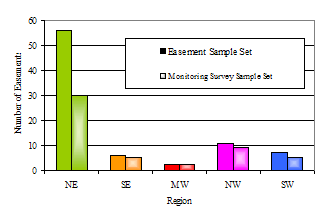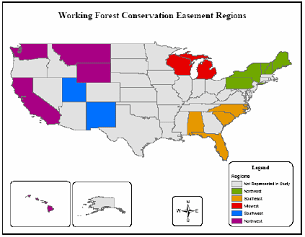 |
||

|
Trends in Easement Language and the Status of Current Monitoring on Working Forest Conservation Easements
Adam Block, Kara Hartigan, Robert Heiser, Gregory Horner, Luke Lewandowski, Jason Mulvihill-Kuntz, and Stephen Thorn Advised by Professor Elizabeth Brabec, J.D., M.L.A.
Project Overview Forestland in the United States is being lost and converted at an alarming rate. This conversion and associated fragmentation greatly diminishes the ability of forests to provide a number of valuable ecological and economic services, such as conserving biological diversity, buffering sensitive areas and reserves, maintaining aquatic systems integrity, and the sustainable production of wood products. However, protection and responsible management of forestland can help ensure quality ecosystem function and promote vibrant local economies. Working forest conservation easements (WFCEs) represent one large and increasingly important approach to reaching these goals. WFCEs have been used with greater frequency by governmental entities and private conservation organizations to protect forested landscapes since the mid-1980s. This study serves as a preliminary work toward gaining an understanding of working forest conservation easements (WFCEs) through a critical examination of two aspects of WFCEs that likely influence the effectiveness of this conservation tool: trends in easement language (from the years 1985 to 2003) and current monitoring methods. Through this research, monitoring professionals, as well as easement drafters, will gain a better sense of the work that is currently being done and use this understanding to best direct future efforts. Research Methods and Findings
The easements were then applied to a matrix that
catalogued all easement purposes and restrictions. This information was
used to create customized surveys for a 39-easement subset of the larger
sample. Monitoring surveys were then conducted with the 23 land managers
responsible for monitoring these 39 easements. These two data sets were
analyzed for important trends. This project was conducted in cooperation with The Nature Conservancy’s (TNC) Upper Peninsula (MI) Conservation Center. TNC, in general, and its Upper Peninsula (MI) Conservation Center specifically, are interested in determining whether or not the use of WFCEs furthers its conservation mission and are also interested in research that will lead to a comprehensive, science-based methodology for monitoring large WFCEs.
The study attempted to answer several research questions: 1) How does easement language (purposes & restrictions) vary in the following six themes by easement holder, by age, and by size? Results From the data collected on easement language (purposes and restrictions listed in the easements), their relationship was analyzed by theme groupings. The use of restrictions and purposes is also compared between regions, size classes, age classes, and easement holder. The increasing use of Forest Management Plans, Best Management Practices, and Sustainable Forestry language in easements is also demonstrated and discussed. The monitoring surveys demonstrated that 87% of WFCEs were monitored (as of fall 2003), and an average of 94% of restrictions were monitored per easement. The range of methods used to monitor WFCEs was documented, and ratings of effectiveness were obtained from monitoring professionals. Of note is the finding that the method most often used is also the one rated as least effective. Restrictions on recreation and the use of chemicals were found to be the least effectively monitored and the least often monitored; highly-visible restrictions such as development, agriculture, and clearcuts were found to be the most effectively monitored. While the results focus on restriction monitoring, purpose monitoring is also addressed. For a more detailed analysis, you can view or download sections of the study report as individual PDFs: The report is also available in a single document (note that this is a large file). Recommendations and Suggestions for Future Research This work provides a preliminary understanding of WFCEs and is meant to serve as a foundation for the future examination of this conservation tool. However, results of the monitoring survey gave us enough insight to offer recommendations to easement drafters and monitoring professionals.
In addition to these recommendations, the research team identified several areas for future research. Future studies conducted in these areas will help to determine the effectiveness of WFCEs and provide the necessary factual information for the improvement of this tool.
Featured Research Project Archives Past Featured Research Projects are stored in the Archives. |
|
Home | Site Map | Search | © 2009 Ecosystem Management Initiative. Terms of Use
 This
study was completed over a one-and-a-half year period by seven graduate
students at the University of Michigan’s School of Natural Resources
& Environment. The group collected and read 82 WFCEs representing
every region of the country (see figure and graph at right) and covering
2,179,544 acres of protected forestland in the United States.
This
study was completed over a one-and-a-half year period by seven graduate
students at the University of Michigan’s School of Natural Resources
& Environment. The group collected and read 82 WFCEs representing
every region of the country (see figure and graph at right) and covering
2,179,544 acres of protected forestland in the United States. Findings
from these studies informed recommendations for improved language and
monitoring regimes on working forest conservation easements.
Findings
from these studies informed recommendations for improved language and
monitoring regimes on working forest conservation easements.